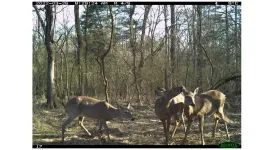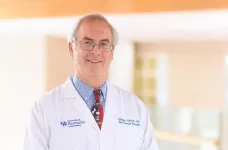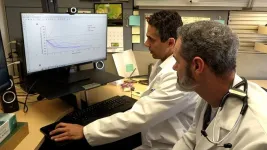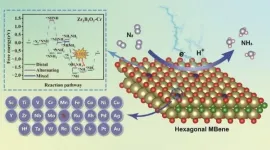(Press-News.org) Madison — A new study from researchers at the University of Wisconsin–Madison finds that ticks can harbor transmissible amounts of the protein particle that causes Chronic Wasting Disease (CWD), implicating the parasites as possible agents in the disease’s spread between deer in Wisconsin. Her findings were published in the journal Nature.
CWD is caused by a pathogenic agent called a prion, which can pass from deer-to-deer through contact with things like prion-contaminated soil and infected bodily fluids such as urine, saliva, blood and feces. Prions, which cause disease in animals and in humans, prompt certain proteins to fold abnormally, particularly in the brain, and prevent these proteins from carrying out their normal functions. Over time, the CWD prion can cause severe brain damage and eventually death in deer.
A lot of CWD studies focus on the role soil plays in spreading the fatal neurological disease among deer. But Heather Inzalaco, a researcher in the Wisconsin Cooperative Wildlife Research Unit, housed in the UW–Madison Department of Forest and Wildlife Ecology, was curious about other potential environmental and behavioral means of transmission.
“Deer live these secret lives; we don't see everything that they do,” Inzalaco says.
She started to consider what sort of things pester deer that could be connected to CWD: Ticks were the perfect parasitic potential culprit to investigate.
Ticks have a goal, of course, to feed on their host’s blood. Inzalaco began to wonder if ticks that acquire blood from CWD-infected deer could also host the prions and if so, could they contain enough prions to spread the disease.
The question became even more intriguing when she discovered that the most common non-aggressive social behavior that deer engage in is allogrooming.
“Deer will groom one another to get places that they can't reach on their own through self-grooming,” Inzalaco says. “If they're grooming each other and they're doing that to remove ectoparasites [such as ticks], that might be problematic because they're probably eating the ectoparasites.”
First, she needed to show that ticks can take up and harbor these prions when they feed on CWD-infected blood. She designed an experiment to do just that.
“You'd think that it'd be easy to get ticks to take a blood meal, but they are surprisingly fussy in the lab,” Inzalaco says.
She was able to determine that ticks can not only carry the prions in their blood meal, they can also carry enough of the agent to potentially infect another animal with CWD. After seeing that the phenomenon was possible in the lab, it was time to see what was happening in the wild.
Inzalaco partnered with the Department of Natural Resources to study ticks collected from deer that hunters harvested and submitted for CWD testing. Of the 176 deer with ticks she studied, 15 of the deer were also positive for CWD. Inzalaco took the ticks from the infected deer and tested the blood they contained to quantify the amount of prion the ticks harbored.
She determined that these engorged, wild ticks did carry transmissible levels of prions — just like those in the lab — making them potential mechanical vectors for the disease.
“They're just like a little CWD tic-tac that are possibly being eaten by the deer,” Inzalaco says.
The study did not test whether prion-carrying ticks did cause transmission to other deer.
Understanding more about how CWD can spread can help improve the management of the disease. While it isn’t practical to treat all wild deer with tick preventatives, Inzalaco believes better land stewardship could help manage tick populations.
For instance, having contiguous habitat of native plant communities and properly managing areas to continue a natural fire regime has been shown to limit tick populations, she says, while more fragmented, unbalanced ecosystems riddled with invasive plants may allow ticks to proliferate more readily.
Inzalaco says it might be possible to use ticks as a way to screen for CWD in both wild and farmed deer. Current methods of diagnosis or screening involve invasive sample collection from animals or tissue sampling after their death. While testing the ticks from deer may not lead to the same level of accuracy as testing tissue samples, it could still be a useful tool to better understanding where the disease is affecting deer population in the state.
Inzalaco also believes her research can help improve the ecosystems that everyone relies on, especially the state’s hunters.
“We are all inextricably linked to ecosystem function and the biodiversity of those ecosystems,” she says. “That is really what drives my desire to learn and do good science on a daily basis. We need to make an effort to preserve our natural heritage so that we can continue living on this planet and not be overtaken by disease and have healthy animals and healthy functioning ecosystems.”
---Elise Mahon, etmahon@wisc.edu
END
Ticks may be able to spread chronic wasting disease between Wisconsin deer
2023-07-07
ELSE PRESS RELEASES FROM THIS DATE:
Doom-and-gloom climate news may scare but also encourage audiences
2023-07-07
UNIVERSITY PARK, Pa. — A team of Penn State researchers investigated how seeing frightening news about climate change day after day may shape the way people feel about the phenomenon and how willing they are to take action to address it.
Christofer Skurka, Jessica Myrick and graduate student Yin Yang found that seeing bad news about climate change can make people more afraid over time, but it also may encourage audiences to think about what society can do to address the problem. They published the results of two separate studies in an article titled “Fanning the flames or burning out? Testing competing hypotheses ...
Name of Portuguese astrophysicist shines in the night sky
2023-07-07
The International Astronomical Union (IAU) has named an asteroid after Pedro Machado, astrophysicist at Institute of Astrophysics and Space Sciences (IA), at the Faculty of Sciences of the University of Lisbon (Portugal). Along with the nomination of Pedro Machado, there were over a hundred other nominations of asteroids and other small bodies.
It is almost three kilometers in diameter and takes four and a half years to complete its orbit around the sun. We’re talking about 2001 QL160, or rather the asteroid 32599 Pedromachado. Pedro Machado has been honored by the Work group for the Nomenclature of Small Bodies (WGSBN 2) of the International Astronomical ...
Charles 'Chipper' Griffith named dean of UK College of Medicine
2023-07-07
LEXINGTON, Ky. (July 6, 2023) — Charles “Chipper” Griffith III, M.D., has been named dean of the University of Kentucky College of Medicine.
Pending approval from the Board of Trustees, Griffith will begin his appointment July 15, 2023. He has served as acting dean of the college since July 2021.
Through the years, he has played an instrumental role in the health and well-being of Kentuckians, and in the academic success of thousands of students.
“Dr. Griffith understands Kentucky needs the UK College of Medicine,” said Provost Robert ...
Updating pulse oximeters
2023-07-07
Updating pulse oximeters
A portable device used to detect blood oxygen levels revolutionized the medical field 50 years ago and is now receiving essential updates
Efforts to improve the accuracy of pulse oximetry readings for diverse groups of patients and in multiple settings are underway. Joel Moss, M.D., Ph.D., a senior investigator in NHLBI’s Laboratory of Translational Research, and Bennett Yang, a postbaccalaureate fellow in Dr. Moss’s lab, describe this process and the future of pulse oximetry research.
Q: Why are portable pulse ...
July issues of American Psychiatric Association journals cover advances in social determinants of mental health, youth mental health screening, AI in psychotherapy and more
2023-07-07
The latest issues of three of the American Psychiatric Association’s journals, The American Journal of Psychiatry, Psychiatric Services and The American Journal of Psychotherapy are now available online.
The July issue of The American Journal of Psychiatry features articles on social determinants of health relevant to racial and ethnic disparities as well as postmortem molecular studies. Highlights include:
Recent Advances on Social Determinants of Mental Health: Looking Fast Forward.
Differences in Social Determinants of Health Underlie Racial/Ethnic Disparities in Psychological Health and Well-Being: Study of 11,143 Older Adults.
The Nature ...
Breakthrough identifies new state of topological quantum matter
2023-07-07
ITHACA, N.Y. -- Cornell scientists have revealed a new phase of matter in candidate topological superconductors that could have significant consequences for condensed matter physics and for the field of quantum computing and spintronics.
Researchers at the Macroscopic Quantum Matter Group at Cornell have discovered and visualized a crystalline yet superconducting state in a new and unusual superconductor, Uranium Ditelluride (UTe2), using one of the world’s most powerful millikelvin Scanned Josephson Tunnelling Microscopes (SJTM). This “spin-triplet electron-pair crystal” is a previously unknown state of topological quantum matter.
The findings, ...
Fecal transplants show promise in improving melanoma treatment
2023-07-07
LONDON, ON – In a world-first clinical trial published in the journal Nature Medicine, a multi-centre study from Lawson Health Research Institute, the Centre hospitalier de l’Université de Montréal (CHUM) and the Jewish General Hospital (JGH) has found fecal microbiota transplants (FMT) from healthy donors are safe and show promise in improving response to immunotherapy in patients with advanced melanoma.
Immunotherapy drugs stimulate a person’s immune system to attack and destroy cancer. While they can significantly improve survival outcomes in those with melanoma, they are only ...
Privacy-preserving collaborative data collection and analysis with many missing values
2023-07-07
To control pandemics like the novel coronavirus infection (COVID-19), data such as the age, gender, family composition, and medical history of infected individuals are required. While patients themselves may provide this information to medical institutions, these details are highly confidential. If the data is properly handled for privacy protection, it can be shared with researchers worldwide without identifying the infected individual, which can help clarify the state of the pandemic and more accurately predict its progression.
There ...
Hexagonal MBene: A promising platform for the electrocatalytic nitrogen reduction reaction
2023-07-07
They published their work on July. 6 in Energy Material Advances.
"In 2017, we reported a new family of 2D transition metal borides as analogues to MXenes and coined a catchy name for them, MBenes," said paper author Zhimei Sun, professor of the School of Materials Science and Engineering at Beihang University. "Up till now, MBenes have been widely studied as catalysts or substrates of various reactions, including HER, ORR/OER, NRR and CO2RR. Notably, the exploration of electrocatalytic performance for MBenes mainly focuses on those with orthorhombic structures, while there are few studies on applying ...
AI tool decodes brain cancer’s genome during surgery
2023-07-07
Scientists have designed an AI tool that can rapidly decode a brain tumor’s DNA to determine its molecular identity during surgery — critical information that under the current approach can take a few days and up to a few weeks.
Knowing a tumor’s molecular type enables neurosurgeons to make decisions such as how much brain tissue to remove and whether to place tumor-killing drugs directly into the brain — while the patient is still on the operating table.
A report ...





